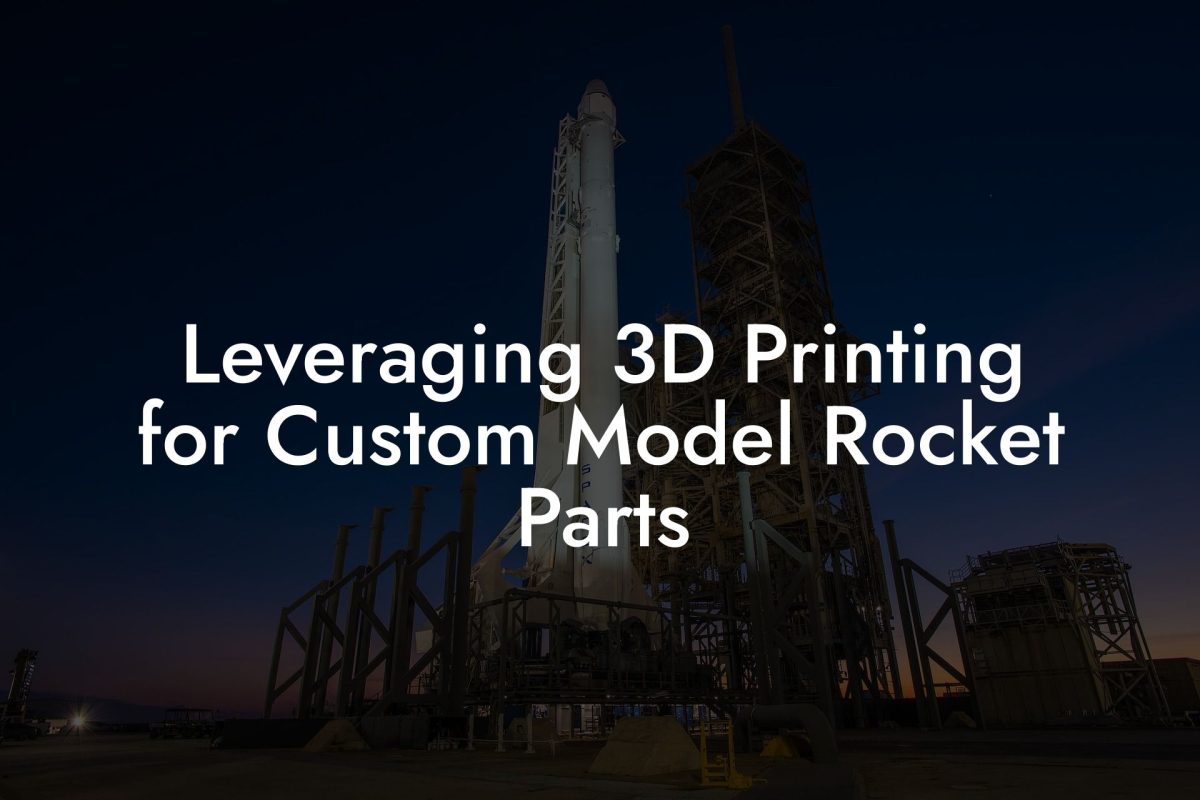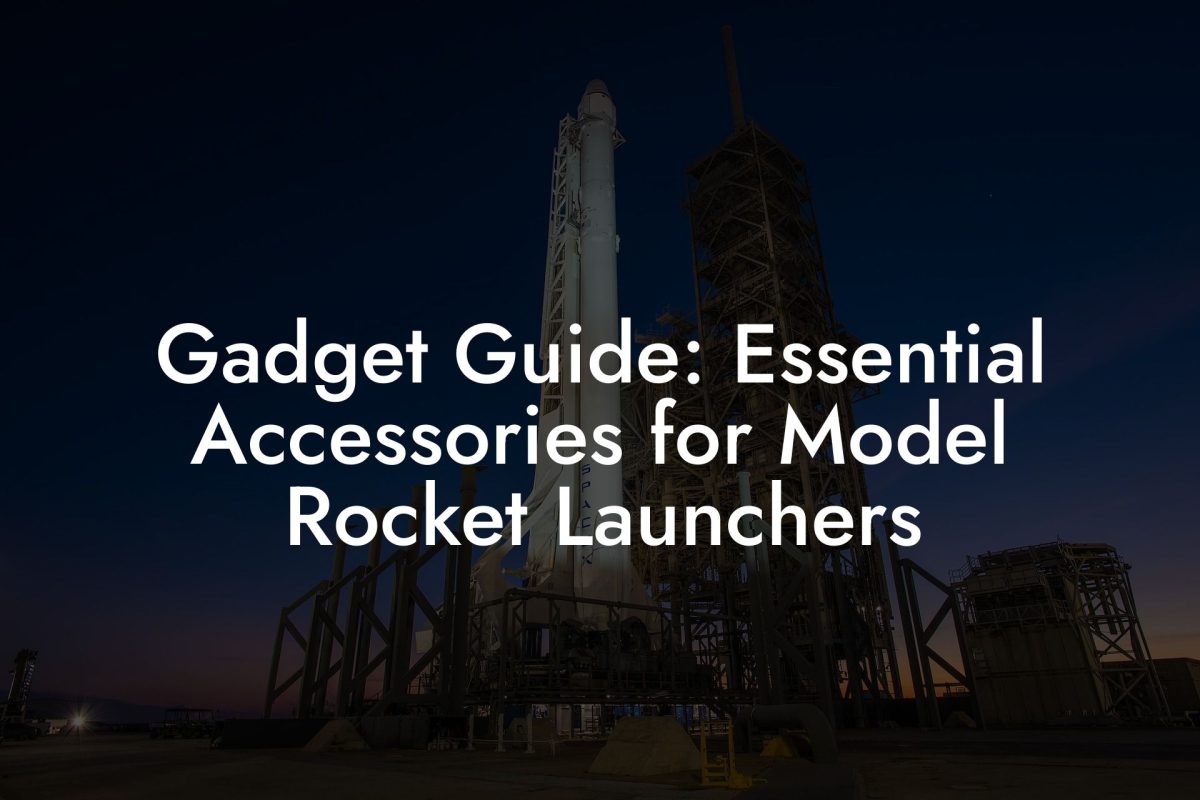In the digital age, model rocketry is no longer limited to physical prototypes and trial-and-error methods. Instead, advanced software tools for design and simulation have revolutionized how enthusiasts conceptualize, test, and refine their rockets. "Digital Innovations: Top Software for Model Rocket Design and Simulation" is your in-depth guide to exploring the cutting-edge digital tools that empower rocketeers to design with precision, simulate real-world flight dynamics, and optimize every aspect of their rocket’s performance. Whether you’re a beginner eager to learn the basics or an experienced rocketeer pushing the limits of innovation, read on to discover how these digital solutions are transforming the world of model rocketry.
Quick Links to Useful Sections
- Introduction: The Digital Revolution in Model Rocketry
- Why Digital Tools Matter in Modern Model Rocketry
- Top Software Tools for Model Rocket Design and Simulation
- 1. Fusion 360
- 2. SolidWorks
- 3. SketchUp
- 4. OpenRocket
- 5. ANSYS Fluent
- 6. RockSim
- Choosing the Right Software for Your Needs
- Case Studies: Real-World Applications of Digital Tools in Rocketry
- The Data-Driven Designer
- The Educational Innovator
- The Competitive Challenger
- Digital Innovations FAQs: Top Software for Rocket Design
- Your Next Launch: Equip Yourself with Digital Precision and Soar to New Heights
Introduction: The Digital Revolution in Model Rocketry
The landscape of model rocketry has undergone a dramatic transformation over the past decade. Traditionally, rocketeers relied on hand-drawn blueprints, physical prototypes, and on-site test launches to understand and improve their designs. Today, however, powerful computer-aided design (CAD) software, computational fluid dynamics (CFD) tools, and simulation platforms allow enthusiasts to virtually model and test rockets before they ever hit the launch pad.
These digital innovations not only streamline the design process but also reduce costs, minimize risks, and enable a level of precision that was once unimaginable. By integrating digital tools into your rocketry workflow, you can predict aerodynamic performance, analyze stress and strain on components, and fine-tune engine parameters, all from the comfort of your computer.
In this comprehensive guide, we’ll review the top software tools for model rocket design and simulation, discuss their key features, and explore how they can help you achieve optimal performance. From beginner-friendly platforms to advanced simulation suites, we cover everything you need to know to stay ahead of the curve in model rocketry.
Why Digital Tools Matter in Modern Model Rocketry
Digital design and simulation tools have become indispensable for modern rocketeers for several reasons:
Looking For The Best Model Rocket Kits? You'll Love These:
- Precision and Accuracy: CAD software allows for exact measurements and intricate designs, ensuring that every component fits perfectly and functions as intended.
- Cost Efficiency: By simulating your design virtually, you can identify potential issues before physical construction, saving time and reducing material waste.
- Risk Reduction: Virtual testing can simulate extreme flight conditions, helping you optimize safety protocols and design parameters without the risk of a failed launch.
- Iterative Improvement: Digital tools provide detailed feedback that can be used to refine your designs continuously, leading to higher performance and better reliability over multiple launches.
- Data-Driven Decisions: Access to real-time analytics and simulation data empowers you to make informed design choices, from aerodynamic tweaks to engine placement and recovery optimization.
Whether you’re experimenting with new materials or testing the latest propulsion systems, digital tools give you a significant edge in the competitive world of model rocketry.
Top Software Tools for Model Rocket Design and Simulation
The market offers a wide range of digital tools tailored to different aspects of rocketry design, simulation, and analysis. Below are some of the top software solutions that are making waves in the model rocketry community:
1. Fusion 360
Fusion 360 by Autodesk is a powerful, cloud-based CAD tool that combines industrial and mechanical design, simulation, collaboration, and machining in one package. Its user-friendly interface makes it accessible for both beginners and advanced users, allowing for precise 3D modeling of rocket components.
Key Features: Parametric modeling, integrated simulation tools, collaborative features, and cloud storage for easy sharing.
Why It’s Great: Fusion 360 is ideal for designing complex components like engine mounts, fins, and modular body tubes. Its simulation capabilities help you test aerodynamic performance and structural integrity before building.
2. SolidWorks
SolidWorks is a high-end CAD software widely used in the engineering industry for its robust design and simulation capabilities. It excels in creating detailed models and offers comprehensive simulation tools for stress analysis and fluid dynamics.
Key Features: Advanced modeling tools, finite element analysis (FEA), and simulation of real-world forces.
Why It’s Great: While it comes at a higher price point, SolidWorks is perfect for rocketeers who require the highest level of precision and detailed performance analysis, especially for advanced and multi-stage designs.
3. SketchUp
Known for its simplicity and ease of use, SketchUp is a versatile 3D modeling tool that is popular among hobbyists and educators. It offers a straightforward approach to designing model rockets and is ideal for quick prototyping.
Key Features: User-friendly interface, extensive library of plugins, and a large online community.
Why It’s Great: SketchUp is perfect for beginners and intermediate rocketeers who want to get their ideas down quickly without a steep learning curve. Its integration with various rendering plugins also makes it easy to visualize finished designs.
4. OpenRocket
OpenRocket is an open-source model rocket simulation software specifically designed for rocketry enthusiasts. It provides detailed simulations of flight trajectories, engine performance, and stability factors.
Key Features: Flight simulation, stability analysis, and customizable engine profiles.
Why It’s Great: OpenRocket is an excellent tool for both beginners and advanced users looking to simulate the complete flight of a rocket, making it invaluable for planning launches and troubleshooting design issues.
5. ANSYS Fluent
ANSYS Fluent is a leading computational fluid dynamics (CFD) software that allows for highly detailed simulation of airflow over complex geometries. While more advanced, it provides deep insights into aerodynamic behavior and can be used to optimize rocket design.
Key Features: Detailed fluid dynamics simulation, customizable parameters, and high accuracy.
Why It’s Great: For rocketeers who want to push the boundaries of aerodynamic efficiency, ANSYS Fluent offers a level of simulation detail that can significantly improve design accuracy and performance predictions.
6. RockSim
RockSim is a dedicated software solution for model rocketry that simplifies the process of designing, simulating, and optimizing rockets. It offers an intuitive interface tailored specifically for rocketeers.
Key Features: Easy-to-use design interface, built-in flight simulation, and engine performance calculations.
Why It’s Great: RockSim is ideal for hobbyists looking for a specialized tool that combines ease of use with powerful simulation capabilities, making it a popular choice for educational settings and home projects.
Choosing the Right Software for Your Needs
With so many options available, selecting the right software depends on your specific goals, skill level, and budget. Consider the following factors:
- Ease of Use: For beginners, user-friendly platforms like SketchUp and RockSim can provide an accessible entry point.
- Feature Requirements: Advanced users may need the robust simulation and analysis capabilities offered by Fusion 360, SolidWorks, or ANSYS Fluent.
- Cost: Free and open-source options like OpenRocket offer great functionality without the investment, while premium software may be necessary for high-level design and analysis.
- Integration: Consider whether the software integrates with other digital tools (e.g., telemetry systems, CAD files) to create a seamless design-to-launch workflow.
By evaluating these factors, you can choose a software suite that not only meets your current needs but also scales with your growing expertise in model rocketry.
Case Studies: Real-World Applications of Digital Tools in Rocketry
Real-world examples highlight how digital innovations are transforming model rocketry. Here are a few case studies:
The Data-Driven Designer
A rocketeer used Fusion 360 and CFD simulation to redesign the rocket’s fins, resulting in a 25% reduction in drag and a smoother, more stable flight profile. Telemetry data from subsequent launches confirmed the improved performance, leading to higher altitude records.
The Educational Innovator
In a classroom setting, educators adopted RockSim and SketchUp to teach students the basics of aerodynamics and rocket design. The software’s intuitive interface allowed students to quickly see the impact of design changes, fostering a deeper understanding of flight mechanics and engineering principles.
The Competitive Challenger
For competitive rocketry, a team integrated SolidWorks with ANSYS Fluent to optimize every component of their multi-stage rocket. By simulating real-world flight conditions and analyzing performance metrics, they achieved precise stage separations and a consistent thrust curve, giving them a competitive edge in altitude and stability.
These case studies demonstrate that whether you’re in a classroom, a competitive arena, or a personal workshop, digital tools can significantly enhance your design process and overall performance.
Digital Innovations FAQs: Top Software for Rocket Design
Here are some frequently asked questions to help you navigate the world of digital rocketry tools:
1. What is the benefit of using CAD software in model rocketry?
CAD software allows for precise 3D modeling of your rocket components, enabling you to design, measure, and modify every aspect of your rocket before physical construction.
2. How does CFD simulation improve rocket design?
Computational Fluid Dynamics (CFD) simulation helps analyze airflow and aerodynamic forces around your rocket, allowing you to optimize shapes and reduce drag for better performance.
3. Is there free software available for model rocket simulation?
Yes, OpenRocket is a popular free, open-source software that offers comprehensive flight simulation and stability analysis for model rockets.
4. What features should I look for in model rocketry software?
Look for user-friendly interfaces, precise simulation capabilities, integration with telemetry systems, and support for iterative design and testing.
5. Can digital tools help improve engine performance?
Absolutely. By simulating engine thrust, burn time, and aerodynamic interactions, digital tools enable you to fine-tune engine alignment and fuel formulations for optimal performance.
6. How do data loggers integrate with design software?
Data loggers capture real-time flight data that can be imported into design and simulation software, allowing you to compare predicted performance with actual flight metrics for continuous improvement.
7. Are mobile apps useful for rocketry design and simulation?
Mobile apps can provide real-time weather updates, flight tracking, and even basic simulation tools, making them a handy addition to your digital toolkit.
8. How important is it to use digital tools in competitive rocketry?
Digital tools are critical in competitive rocketry, as they allow for precise design, simulation, and analysis, giving teams a significant advantage in optimizing performance and consistency.
9. What is the role of digital telemetry in rocket design?
Digital telemetry provides real-time flight data that informs design decisions, helps troubleshoot performance issues, and allows for iterative improvements based on actual flight conditions.
10. Where can I learn more about using these digital tools?
Online tutorials, rocketry forums, specialized workshops, and YouTube channels are excellent resources for learning how to effectively use CAD, CFD, and telemetry software in model rocketry.
Your Next Launch: Equip Yourself with Digital Precision and Soar to New Heights
Digital innovations have transformed model rocketry, empowering enthusiasts to design, simulate, and optimize rockets with unprecedented precision. With the right software tools at your disposal, you can reduce risks, enhance performance, and iterate on your designs to achieve extraordinary flight outcomes.
Embrace the digital revolution in rocketry, leverage the power of simulation and telemetry, and let your designs take flight. Your next launch is just a click away, equip yourself with the best digital tools and propel your rocketry adventures to new heights!
Looking For The Best Model Rocket Kits? You'll Love These:
Useful Interruption: Dive deeper into the world of Model Rockets with our most popular sections. If there is anything you think is missing or anything you would love for us to write about, just give us a shout.
- Getting Started & Basics With Model Rockets
- Model Rocket Design, Build & Customization
- Model Rocket Propulsion & Engine Technology
- Model Rocket Launch Techniques & Recovery
- Model Rocket Advanced Rocketry & Innovations
- Model Rocket DIY and Customization
- Model Rocket Equipment Reviews & Digital Tools
- Community, Competitions & Education
- Model Rocket Troubleshooting & FAQs
- Model Rocket Bonus/Seasonal & Niche Topics
A group of model rocket enthusiasts gathered at a field for their weekly launch event. Among them was Dave, a seasoned builder known for pushing the limits of hobby rocketry. This time, he had outdone himself.
“Ladies and gentlemen,” Dave announced, dramatically pulling a cloth off his latest creation, “I present to you: The Kraken!”
The crowd gasped. This wasn’t just a model rocket, it was a monster. The thing stood 8 feet tall, had six clustered engines, and was covered in enough duct tape to qualify as a classified aerospace project.
“Dave,” muttered Steve, the cautious safety officer, “Have you, uh… done the math on this?”
“Math?” Dave scoffed. “I built it in my garage at 3 a.m. with parts from eBay. This is an art piece, Steve.”
The countdown began.
5…
4…
3…
2…
1…
The engines ignited with a BOOM, and The Kraken shot up… kind of. It immediately did a violent barrel roll, narrowly missing the spectators before skyrocketing at an angle that could only be described as “legally questionable.”
The crowd collectively ducked as The Kraken flew straight over the adjacent cornfield, where Old Man Jenkins, the grumpiest farmer in town, was minding his business.
KABOOM!
The rocket disappeared behind the barn. A moment later, a flaming piece of Estes igniter wire landed at Steve’s feet. The silence was deafening.
And then, an unmistakable sound echoed across the field.
Jenkins’ shotgun being cocked.
“DAVE!!!” Steve shouted. “RUN.”
And that was the day Dave invented the first-ever biologically powered rocket booster: pure adrenaline.
To this day, nobody knows where The Kraken landed, but legend has it, it still haunts the skies, terrifying unsuspecting drones and low-flying birds.








